The Art of Mourning - Enamel Mourning Bands, Guest Blogger: Part I
I am so excited to introduce you to our Guest Blogger today! Writing for your enjoyment all the way from Australia, I am honored to introduce Hayden Peters from The Art of Mourning - a resource for memorial and mourning jewelry. Hayden is one of the experts in the field of mourning jewelry and I am so very excited that he has graciously agreed to discuss enamel mourning bands (one of my personal favorites!) with us today in Part 1 of this two-part, joint series.
So, I hope you enjoy this amazingly educational and fun post from today's Guest Blogger, the incomparable Hayden Peters!
 |
| Hayden Peters from The Art of Mourning. |
Collecting is an art in itself. Discovering facts about a jewel helps one find out more about the life of the person who wore it and how their emotion created something which they felt was a way of representing themselves within society through a jewel. Recently, the Inspired by Antiquity blog reached out to me with a ring dedicated to ‘Lois Boyes 24 July 1820, age 47’. Regardless of its condition, it requires a strong opinion in terms of why it was created, how it was worn, what the circumstances were to form its creation in fashion and how society was changing. To do any less for such a special jewel would be to invalidate the memory of Lois Boyes, as this ring still retains all the essential elements of memory that were infused within design of the 1820s, a time when society was changing to be more recognisable to what we know today.
In the 1820s, love took on simplistic elements of design to establish a link to a loved one. While larger style portraits remained popular, the smaller Neoclassical designs with their allegorical motifs of love and grief had been replaced by finer gold work design and the use of gems to create a message of love for a person. Above this, hair was placed above gems, often in the bezel and woven under glass. The literal statement of the loved one becomes the primary material of love, regardless of grief, because the very nature of the memory of the person in their absence is enough to wear a piece of them.
It’s from this period that much of the floral symbolism that stretched through the 19th century and became standardised as we know it today began. The Romantic period, along with economic troubles caused by the Napoleonic Wars and also the advancements of the Industrial Revolution sped along automatic construction processes with lower grade materials. This was also helped through greater access to materials, such as the Oriental Pearls which came from the Persian Gulf through trade caravans in the late 18th century. Style and fashion aren’t simply singular catalysts, but a mix of various pieces to make a complete whole.
When looking at this ring, the insights into the advancing Gothic Revival style show the influence upon mainstream jewels that Augustus Welby Northmore Pugin, a designer, architect and convert to Catholicism, had upon what style was. This was largely a push back to the values of the Medieval period and a remark on the excess of the times, particularly that of George IV.
For the Collector
The ring puts forward a series of questions in regards to what elements can fundamentally state what a jewels age and construction are. From a design perspective, one can look to contemporary jewels seen in this website as to what a typical jewel would look like, but there are other factors to take into account.
Hallmarking is the best standard to identify a piece, but unfortunately (although mostly illegal), jewellers are known to falsely stamp pieces. Hallmarking is the process of stamping precious metals, as they are intended to be stamped by the Assay Office to guarantee purity of the piece.
When collecting, it is necessary to bring a hallmarking book along to assist with the identification of pieces, as the listings are so vast that there is no way to fully comprehend each and every stamp.
Recommended is Jackson’s Hallmarks, and excellent and conveniently sized reference book for transport and identification. Hallmarks are the most honest way to find the maker and year a piece was created, with both gold and silver.
Earlier pieces do not have hallmarks with which to guide the collector, but 19th century pieces are easy to identify. Be sure hallmarks match and that they are honest to the piece. Many pieces have been falsely stamped in recent years to give a piece provenance, but can often be false. Check the marks have consistent wear with the piece and that the year / maker and any tax or import marks match.
Gold and silver were marked with the same standard until 1798, when the introduction of 18 carat gold required standard gold marking. However, 22 carat was stamped with the same marks as sterling silver until 1844. The demand for cheaper gold watch cases in America saw 9, 12 and 15 carat added to the marks in 1854. This means that by 1854, there were marks for 9, 12, 15, 18 and 22 carat. 14 carat was introduced in 1932, replacing 15 and 12 carat, creating the current four standards: 9, 14, 18 and 22.
Gold marking is a difficult standard to follow, as (pre 1906) some countries did not stamp and quite often, pieces are unstamped regardless of territory. Most commonly, the US used 10K, 14K and 18K marks; many memorial pieces were 9 carat, given their popularity and ubiquitous nature post 1854. In Europe, marks are generally for the fineness of the metal and the following carat indicators are not exactly accurate representations of the numbers: 750 / 18 carat, 375 / 9 carat and 625 / 15 carat.
Pinchbeck, a form of brass (an alloy of copper and zinc) is a very popular material used in mourning pieces from the middle of the 19th century. Be sure that when buying a piece it is not for its gold content in these cases. Often, the clasps are marked, with other fittings pinchbeck.
Quality shouldn’t be a factor with the mourning and sentimental collector. The key difference with these jewels is that they were created for a loved one and that is more valuable than any material which could be used. In the case of this ring, there are the remnants of what it once was, but the inscription still remains and that is part of a family’s history.
Enamel Colours
Elements of this ring reflect what it once was. There are traces of the blue and white in the band (blue) and the white (inlay) which represent the values of the person and the family who wore and viewed it. This is a fundamental statement and couldn’t be confused with the simple black colour that was seen in many mourning jewels, due to the understanding of what the colour meant.
Colour theory is nothing new to modern times. Colour is the identity of emotion, be it red for passion (love or anger), black for death or blue for royalty (a more modern concept). Since the Renaissance, coloured enamel in jewellery was not uncommon, with various techniques taken from classical methods to be applied to jewellery construction. From the Cloisonné, where wire creates the definition of the enamel filling, being an antique technique, but seen in use from 12th century examples, to the champlevé, where the ridges are filled with enamel. Any technique which could be used to infuse a jewel with colour meant that its identity could be changed depending on what the colour was. For a jeweller, particularly in the 1840s onwards, having enamelled jewels with specific colours pre-designed would be easy to tailor for anyone wanting an interior inscription for sentimentality.
Green enamel shouldn’t be seen as a modern invention on jewels from the 19th century. In this early 17th century ring, one can see the remnants of the green enamel in the shoulders of the ring, balancing with white enamel, used effectively here for bones. The Latin inscription states ‘FOELIX CONCORDIA FRATRUM’ (a happy concord of brothers), bringing this memento mori ring into the realm of fraternal love in its construction, rather than being of direct mourning connotations. Rudoe and Dalton also have assumptions about the piece: Text from Dalton 1912, Catalogue of Finger Rings:
'Compare nos. 812-22, which, not having names or initials, have been classified as devotional. Rings of the memento mori type were, however, used as mourning rings; jewellers probably stocked them, and names or initials were subsequently added to order… they may be regarded as potentially mourning-rings, though some might equally well be considered devotional.' The inscription indicates that this ring commemorates the death of two brothers - perhaps twins- who died at the same time. The back of the bezel bears a letter H above I and A, the standard way of indicating two members of the same family: the initial letter of the surname above and the initial letters of the two Christian names below (J. Rudoe, 19.11.03).
If this was a ring which had been used for the dual purpose of being a memento mori ring and also for mourning (they weren’t originally mutual as a concept), then the ring may have been worn as a token of personal identity first, between brothers, then tailored for the purpose of mourning later. Regardless of this, the nature of the green enamel as being a balance of colour for the skull and the bones is simply a colour which was fashionable. The concept of rebirth and rest hadn’t been introduced until the Romantic period. It was only by the 18th century that synthetic dyes had replaced vegetable pigments and dyes in art, which led to a greater permeation of green as a visible colour in design and arts. When something is ubiquitous enough, then it can gather a meaning which a population can understand, but this ring was early enough for the colour to resonate design over symbolism.
Memento mori jewels and those of the late 17th and early 18th century benefitted from the use of material in their construction, as they could involve colours easily and adapt. In the above example, the use of green is seen to be the basis of material which the cipher and crystal sit upon. Most interesting about this ring is the use of silver over gold and the integration of the garnets into the shoulders, which all balance to make this quite an opulent ring for its time. In its use of green, there is more of a personal slant to the nature of the ring, rather than being a symbolic meaning for identity.
The above examples are nearly a century apart, finding their difference between mourning and sentimentality, with one being at its height for memento mori style (adapting to mourning through the use of the skull/crossbones motif later on) and the decorative faceted crystal, rosette reverse bezel of the early 18th century. Both use green as an identifier, yet neither place the colour above the sentiment itself. It could be argued that the latter ring has more identity, due to the material being intrinsic to the family/individual who is being remembered. This is not uncommon, be it a piece of material that was worn, kept or even from the funeral of the deceased, which has been seen in latter 18th century jewels.
More interestingly is this ring from c.1700, with the reversed enamelled bezel that had been popular since c.1680. This variation is highly decorative, whereas most others show enamel in the rosette shape inlay, this has the enamel inlay to a hammered pattern. The green still shows through at the star-shaped pattern on the reverse, balanced with blue enamel and the white dots, perhaps reminiscent of the night sky. Green should not be seen as the primary driver for what these jewels stood for. They were created for their sentimental reasons, but either for the use of the initials or the skull (with its reverse initials) identifying what their statement meant kept the design relegated to the primary motif in the bezel. There were not completely green coloured mourning jewels for the sake of identifying death. Death was used in black and white, each being an extreme to show death as its entropy, or white for its purity, but neither being green, blue or red as a primary colour.
By 1715, the memento mori symbols had changed from what we’ve seen in the first ring to become the symbol of death, the loss of time and eventual judgement. These symbols engrained within society the nature of living a life for eventual death and what the afterlife would bring. In this 1715 example, the use of the green enamel is quite clear upon the hour glass (tempus fugit), in which time flies and this is the symbol of life. As with the previous jewels, this is a symbol that is not the primary colour (in this case, being black). Green is used here as the fire of the torch, which the skeleton is holding. Green replaces the orange/yellow/blue fire, but also lends towards the fire burning brighter as an extreme temperature as well as a decoration.
On the reverse of miniatures and on the trim or border of brooches or clasps, green enamel or green foil, was seen as a popular way of denoting status of love and sentimentality through colour. Being further removed from the jewels seen earlier, green was now becoming a colour that could be identified with rebirth, growth, renewal and rest. The Romantic period had influenced jewellery through art by stating that colour theory was important and not a periphery to the symbolism seen in art and jewellery. Previous to the above jewellery, an urn or column with burning hearts would be seen; clearly showing death or love in its statement. Now, it was the use of colour, pearls and the simplicity of the woven hair in a dedicated area. The 1860s and the latter 19th century didn’t change the conceit of green as a symbol, but only used it sparingly where it resonated with the wearer/person whom commissioned it. What is interesting about all of these jewels is that as they progress, there is still the balance of white enamel with the green enamel. If used for the purpose of death, white (purity/innocence) and green (rebirth) is almost a call for the unmarried, virginal youth to grow once more. Be it literal or for the sake of sentimentality, green enamel began to take its form as a colour which was acceptable during the third stage of mourning. This resonated through to the 20th century with the Romantic Revival of the c.1900 period, where jewels used colours frequently and utilised green as a colour in enamel and foil to replicate the styles of the early 19th century. Miniatures and oval styles found their place in mainstream jewellery designs during the pre-WWI era of the 20th century, where some jewels are so perfectly replicated that they can only be judged by their weight. Black enamel is possibly the most common and identifiable of the enamel colours to be seen as that of a death identifier. What we’ve seen in this green enamel ring is that death did not have to be resonate of black, but other colours could be used for mourning. Showing an example from the 16th century, this is an early ring to feature black enamel inlay inside the ring itself. This piece has the inscription:
“*TO*YOV*ABOVEN*ANI*CREATVRE MY*HARTE*TO*THE*DETHE*SHAL*ENDVRE”
“To you above any creature / my heart to the death shall endure” - written in a phonetic way (prior to the creation of the English dictionary) to show the influence of death as a motif, hence the black enamel, with the loving sentiment that goes with it to unify the couple forever. Without the standardisation of the English language and the written reliance on Latin previous to the dictionary in 1755, posie rings are a remarkable time capsule for phonetically capturing their surrounding language in a jewel. From a status perspective, this utilisation of language is accessible to a strata of society that didn’t have the luxury of formalised education, opening up sentimental jewels to new levels of society. Basic sentiments of love etched into silver and gold bands could now be given as a secret love token for a growing middle class. In rings previous to the 16th century, more common would be the inscriptions written in French, Latin and Norman French. Chapbooks, pamphlets containing popular literature, were a popular source for many of the sentiments written inside the posie rings. These cheap pamphlets grew in popularity, as they were sold cheaply (commonly a penny or halfpenny) and contained many popular ballads from the time. This pre-dates mass produced media of the early 19th century, when steam presses led to the rise of cheap newspapers. From the mid 16th century, these cheap and crudely produced booklets contained relevant popular content that varied from entertainment to political and religious content. Here, the relation of the ring to the popular literature is the key factor in understanding just how the posie’s relation to society. They were jewels that could be for the commoner, but also transient as a style of love token through society because of their simple statements.
White enamel is the second most popular mourning material used, next to black enamel. Black enamel, being a colour that has represented death through to pre-history, was (and still is), the colour that was inlaid in jewels, most commonly with the 'IN MEMORY OF' sentiment. This was highly standardised by the 19th century, but in the 18th, there was much more flexibility with the use of sentiment and enamel colour.
Death, for its reasons of desecration and entrance into entropy, lead towards black, which in itself, is the absence of light. White, when in use, is the connection to purity, innocence and virginity, show the untarnished representation in colour towards a person's morals and values. A young person who was not married was seen as unblemished in social status and the use of the white enamel to show this virtue is why white enamel is used in this context. Colour and symbolism became the primary elements of the mid-18th century, with the introduction of the Rococo period and its infusion of naturalistic designs in jewellery. The previous Baroque period was notorious for its bolder, dominating design, however mourning jewels represent something far more personal than what could be reflected in grander statements of building and architecture. Cost and the essential nature of wearing a mourning jewel requires that the wearer invest some intrinsic personal affectation into the jewel and that the jewel must reflect something of its time. The 18th century essentially established the industry of mourning, due in part to the Industrial Revolution and the rise of faster methods of production and a society which was becoming more and more mobile, with greater access to education and techniques. In 1686, the revocation of the Edict of Nantes led to Huguenot goldsmiths and jewellers emigrating to Great Britain. This was when the previous allowance by Henry IV of France provided Calvinist Protestants (Huguenots) significant rights. With this retraction, the Huguenots bought with them skills which enabled the London trade to compete with Paris. This led to greater patronage with the influx of greater designs and new elements of fashion appearing as popular in jewels. By the mid 18th century, much of the values that were carried to Britain were instilled within the new industry and led to such elements as the Rococo designs in jewellery from its continental influence. These new techniques applied to the white enamel that is displayed in Henry’s 1774 ring. Not only did the inlay of enamel become a process which was being influenced by the influx of skills from the continent, but the styles that the Protestants introduced into England allowed for a cross-cultural sharing of new ideas. White enamel as a virtuous display of young life was becoming a mainstream consideration, which this run from 1699 shows.
After this influx of Huguenot talent, the mourning industry grew along with jewellery development. Mourning rings were flourishing under a stabilised government that had not been seen under the Interregnum (Cromwell) period, as well as the new wealth that was developing from the burgeoning Industrialisation movement. Comparing this ring from 1730 to the 1699 piece, there is a large degree of standardisation in the design elements. This is a ring produced after the various elements of mourning in jewellery had become common enough to interpret without being seen as a jewel for aesthetic purposes. This is clearly a ring made for the purpose of grief in the style of its time. Gone are the memento mori elements (though these were still fashionable, however they had become smaller in size) and introduced is the name and dedication of the ring written around the band.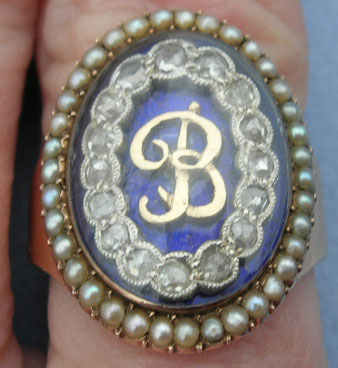

An important colour for use within the primary pendant of this article is the use of the cobalt blue. It was a popular colour in glass to use in miniatures, be they sentimental or mourning, yet it has symbolic importance also.
The use of blue enamel (used for royalty and suggesting that one was considered royalty) contains many mixed histories. Over time, many of the messages surrounding cobalt glass and blue enamel have been crossed, yet it fit very well into the Neoclassical paradigm post c.1865. The main reason for its use in heavier, symbolic terms is that the Neoclassical reliance on sentimental depictions and the allegories of love put the reliance on peripheral representations, rather than clear-cut statements of love and faith. Hence, blue enamel, considered royalty.
There’s Royal Blue and there’s Bleu de France. Bleu de France has been representing France and the French monarchy and the heraldry since c.12th century. This was adapted into jewels and you can see the obvious connection there with the message of royalty, especially considering the French influx into other cultures, as the French were considered the focus of style and fashion. Royal Blue, is darker, with a hint of purple and red. This was thought to have been invented by millers in Frome, Somerset during a dress making competition for Queen Charlotte post 1761 (after she was queen). There’s the connection here in that her style would dictate a lot of the aristocracy would consider high fashion.
The Acanthus and Floral Motif; How The Gothic Revival Used Style
As can be seen around the exterior of this ring, the floral motif harkens back to the Baroque designs of the 17th and early 18th centuries, an important design to be taken into context with the Gothic Revival period. This style helped usher in a reflection on pre-Neoclassical art, which, when worn, only amplified its statement of conservatism. But it was also beautiful as a design, which doesn’t necessarily mean it was within the values of the wearer. Style changes without making a statement even today. There’s no reason why this ring would equate to a hard line in traditional values, this was just the feeling of the time. To substantiate this, the enamel colours relate quite heavily to the Neoclassical period and its colour system. This did follow through the 19th century, but predominantly with black enamel and a lessening of the white and blue, particularly post 1850.
In the 1820s, many influences upon society offered greater cultural flexibility within the social structure. The excesses of George IV and his investment in the arts bought new influences into the United Kingdom. From the death of Princess Charlotte who died in 1817, mortality was absorbed as a cross-cultural, kingdom-wide event, imposing values of the affectations of mourning on people which would resonate for the remaining 19th century. The values that were appropriated to show this in fashion led to the Gothic Revival being the identifier for grief and virtue, due to its return to religious values and simplicity that takes that pomp away from the fact of death.
The Gothic Revival period of the early 19th century is an extremely pronounced period of obvious consequences in art and architecture, but also heavily affecting in morality and cultural lifestyle. It is a period that overlapped other forms of mainstream style to eventually become the dominant visual presence, particularly in memorial jewellery and had left its mark for the greater part of the 19th century.
Firstly, we must look at this emerging style to conflict directly with the ideals of the Neoclassical period. Though the Neo-Gothic movement had begun c.1740, it took around sixty years for it to reach mainstream thought, a time when Neoclassicism was at its height.
Much of this thought was a reaction to religious non-conformity in an effort to swing back to the ideals of the High Church and Anglo-Catholic self-belief. This was a time when heavy industry was on the rise and modern society (as we consider it today) was established, a time of radical change that challenged pre-existing ideals of society. Though there had been growing small scale social mobility from the late 17th century, the late 18th and early 19th centuries saw the middle classes having the opportunity to promote through society with the accumulation of wealth.
Augustus Welby Northmore Pugin, a designer, architect and convert to Catholicism, saw this industrial revolution as a corruption of the ideal medieval society. Through this, he used Gothic architecture as a way to combat classicism and the industrialisation of society, with Gothic architecture reflecting proper Christian values. Ideologically, Neoclassicism was adopted by liberalism; this reflecting the self, the pursuit of knowledge and the freedom of the monotheistic ecclesiastical system that had controlled Western society throughout the medieval period. Consider that Neoclassicism influenced thought during the same period as the American and French revolutions and it isn’t hard to see the parallels. The Gothic Revival would, in effect, push society into the paradigm of monarchy and conservatism, which would dominate heavily throughout the 19th century and establish many of the values that are still imbued within society today.
The above necklace and pendant were made for Louisa Burton, Pugin's second wife. Commissioned on the 21st of December 1843, through John Hardman & Co. of Birmingham, the piece was described as 'A Gold enamel Chain & Cross' costing £47. It is a supreme example of Gothic Revival perfection in its dominating Christian Medieval style. Sadly, Louisa died eight months later and the cross and chain became part of the parure (set) of jewellery that Pugin intended for this third bride, Helen Lumsdaine. Pugin persuaded her to convert to Catholicism, but before the wedding, Lumsdaine's family insisted against the marriage. Pugin married Jane Knill, a Catholic, in 1848, whom it was said that "her every jewel mounted 'in a Gothic setting'. Queen Victoria herself admired this piece at the Great Exhibition of 1851 in Pugin's 'Medieval Court'.
Much of the latter 19th century pieces had their origin in this Gothic Revival period, the bold styles with black enamel as well as being larger accommodated the evolution of female fashion, which heavier crinolines and cuffs, seemed to be a perfect fit. Styles didn’t automatically become larger due to the Gothic Revival influence, much of the older styles adapted Rococo acanthus designs and incorporated Gothic fonts into the lettering of the dedication in the pieces, which emerged around the c.1800-1810. By the 1820s this style was influencing brooches, rings, pendants and lockets more and more, until the 1830s when it reached its height, particularly in terms of diversity. Through the 1840s it had become the standard and into the 1850s, there was the Hallmarking Act of 1854 that allowed the use of lower grade alloys. Reflecting this upon the larger styles of female dress, pieces could be larger and lighter to wear, yet still give all the bold, gold and black enamel prominence of the pieces themselves.
The 1820s, Fashion and Contemporary Jewels
During the 1820s, style and fashion went through a major change which would lead into the oncoming Victorian era. It was the balance of the changing Neoclassical period and its influence of jewellery and costume.
Johann Kaspar Lavater’s Essays on Physiognomy from 1775 helped to define what classical style meant to modern fashion and personifying classical idealism. Popular culture is one of the greatest triggers of modern fashion, with no one moment being the catalyst for change. French fashion has been a modern pillar of style, with the Revolution creating a wide dispersal of fashions and the creation of new ones. In 1804, the Napoleon’s Empire was announced and luxury trades were renewed with vigour. Bijoutiers, who worked in ordinary materials and joailliers, who worked in precious stones benefitted from this rise in luxury, with Napoleon requesting the jewels from the former kings of France to be set in the Neoclassical style, essentially connecting him to the Greco-Roman empires. His coronation crown was decorated with cameos and his passions for the antique world led him to establish a school of gem engraving in 1805. If ever there was a height for the Neoclassical period, it was this connection to it. How other societies would reflect this moment is seen in their contention or support of Napoleon. Here is a person who is appropriating the classical world in a time where it had been in mainstream thought and fashion for around forty years. International tension would only lead to the decline of this style, as cultures needed to obtain their own identities in jewellery fashion. A great push to the Gothic Revival style in England has its roots in this.
Johann Kaspar Lavater’s Essays on Physiognomy from 1775 helped to define what classical style meant to modern fashion and personifying classical idealism. Popular culture is one of the greatest triggers of modern fashion, with no one moment being the catalyst for change. French fashion has been a modern pillar of style, with the Revolution creating a wide dispersal of fashions and the creation of new ones. In 1804, the Napoleon’s Empire was announced and luxury trades were renewed with vigour. Bijoutiers, who worked in ordinary materials and joailliers, who worked in precious stones benefitted from this rise in luxury, with Napoleon requesting the jewels from the former kings of France to be set in the Neoclassical style, essentially connecting him to the Greco-Roman empires. His coronation crown was decorated with cameos and his passions for the antique world led him to establish a school of gem engraving in 1805. If ever there was a height for the Neoclassical period, it was this connection to it. How other societies would reflect this moment is seen in their contention or support of Napoleon. Here is a person who is appropriating the classical world in a time where it had been in mainstream thought and fashion for around forty years. International tension would only lead to the decline of this style, as cultures needed to obtain their own identities in jewellery fashion. A great push to the Gothic Revival style in England has its roots in this.
Simple designs and smaller jewels following in this early 19th century period. The geometric shapes, ovals, circles and rectangles became popular, with the Greek key pattern utilised often in jewels. It was about balance, with many patterns being taken directly from Greco-Roman architecture and detail. During this time, until his remarriage, Josephine was the bastion of style, maintaining the fashion which people would covet.
From this, what we see is that society had to adapt to the shock of the Terror and the new Empire, all the while other cultures are looking to France for its style and reestablishment. Greater and more literal influences of antique cultures led to the allegory of the sentimental depictions becoming literal interpretations of their architecture in jewels, making the individual the monument to classical art itself.
It cannot be understated how important the French influence upon sentimental jewels was in the turn of the 19th century. From the souvenir jewels stating such terms as “Souvenir d’amitié” and “Souvenir d’armour”, the statements of love that were worn on display created a new social proprietary that involved the use of sentimental jewels to offer admired people, within social circles, as signs of courtship and love.
Much of this sentiment stemmed from the French Revolution and its cultural challenge to established monarchy and religious value systems, particularly in the form of Liberté, égalité, fraternité (liberty, equality and fraternity). While the French Restoration of the first-quarter 19th century had repaired the monarchy itself, the challenge to established order had accomplished a lot to put new values in relationships and empower individuals. George IV encouraged society to look externally for artistic influence, since his ascendancy (and Regency, post Regency Act of 1811), George’s investment in the arts was required for the aristocracy to have these tokens of love as social requirements above simple affectations.
The Bourbons were restored in 1814, with jewels being more sedate in their designs due to the lack of wealth. Threaded seed pearl on horse hair created ornate bracelets and necklaces, with materials being smaller and more abundant to exaggerate their use. During the 1820s and 1830s, the use of cannetille (surface covered with wire) or grainti (small granules) embellished the colour of gemstones, as the gold was used in the base of the jewel. As seen with the portrait of Lady Peel by Sir Thomas Lawrence above, the wearing of several bracelets and enamelled rings on one finger elaborately exaggerated the colour of the jewellery. Classical style was starting to become overcome with elements of the Baroque and Rococo, which had only been popular previous to the Neoclassical period.
How this affected the mind of the early 19th century individual was a direct stylistic move away from what had bought about the unrest of the Neoclassical style. With competing styles being mixed for mainstream appeal, the classical style in its literal form would recede until the mid 19th century and the archaeological discoveries that would ignite it once more, such as Etruscan.
Connecting and Collecting
Altogether, this ring has a tale to tell just from its very appearance, notwithstanding its actual dedication of Lois Boyes. Tiffany at the Inspired by Antiquity blog will be investigating the heritage of the ring, tracing back the family and finding more out about who this ring was created for.
Collecting is more than simply being a curator for a jewel, it’s about being an amateur historian. To simply have a jewel for the sake of ownership is a disservice to its history and to the public who could be viewing it for its historical appreciation. When we look at a ring like this, its message carries a story that grows as time goes by.
Courtesy: Inspired by Antiquity, Barbara Robbins, The V&A Museum, Pip Terry
Be sure and follow Inspired Antiquity on Facebook: https://www.facebook.com/InspiredAntiquity, Twitter: @NpiredAntiquity, Pinterest: www.pinterest.com/tkmb & Instagram: InspiredAntiquity
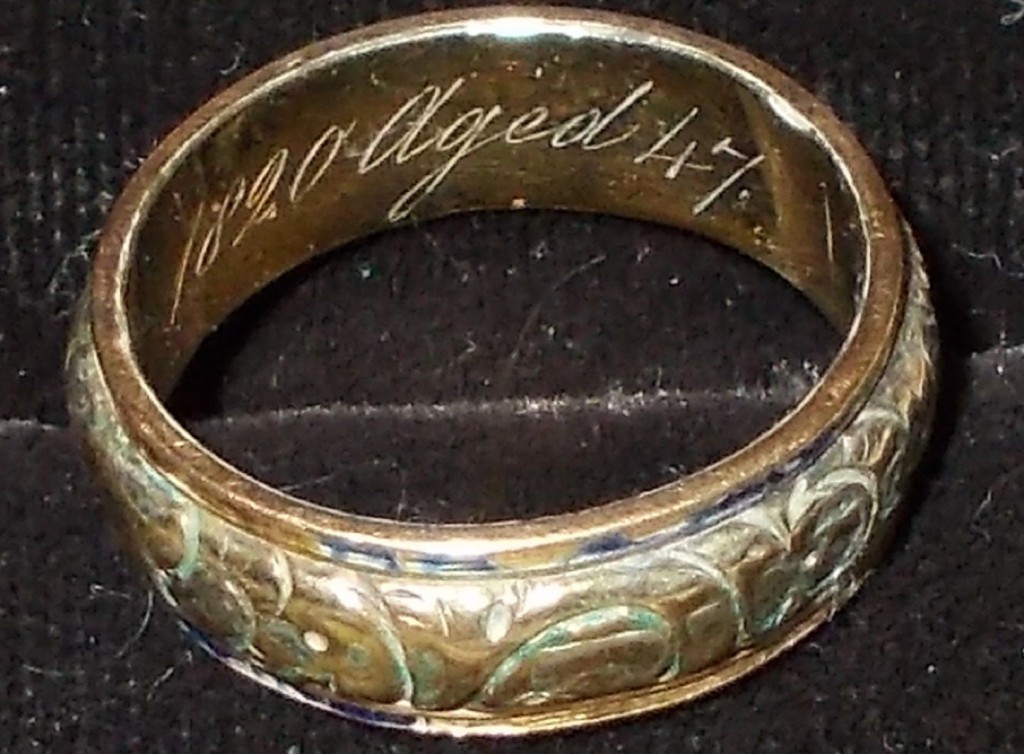

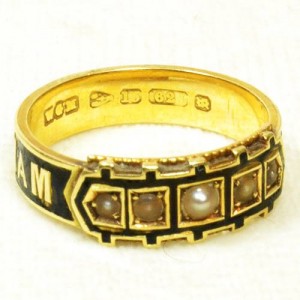

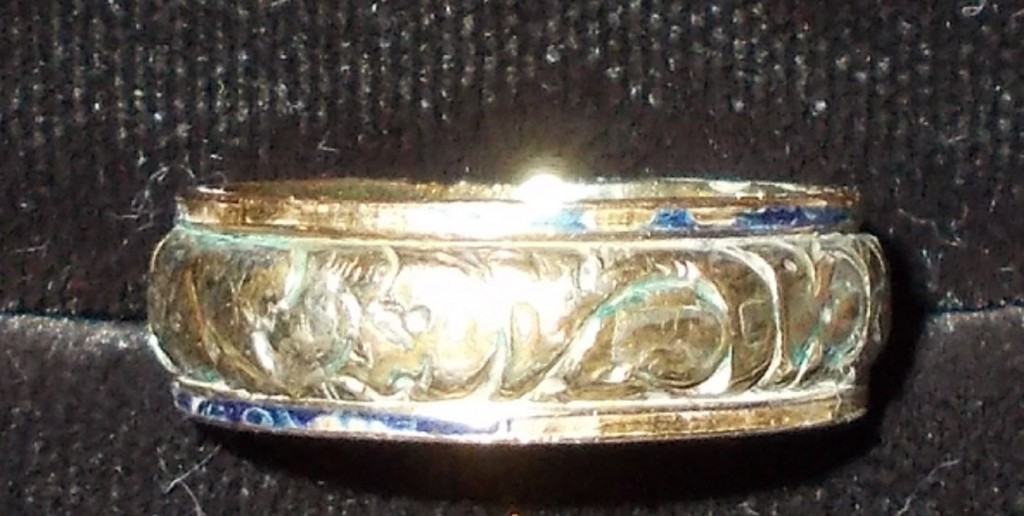
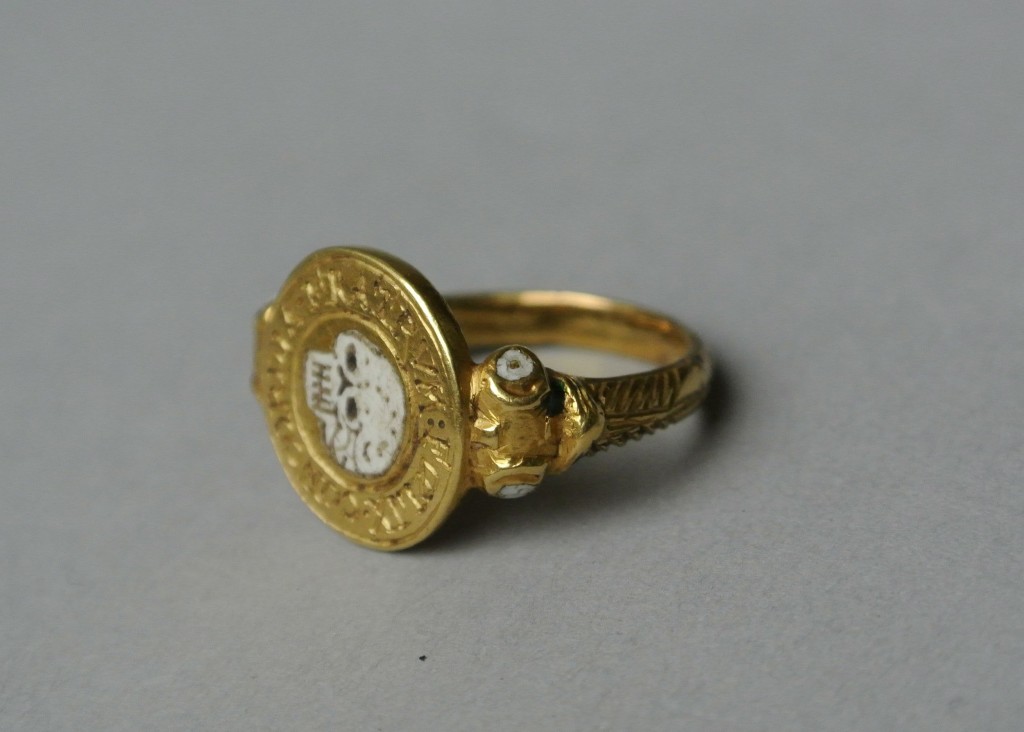
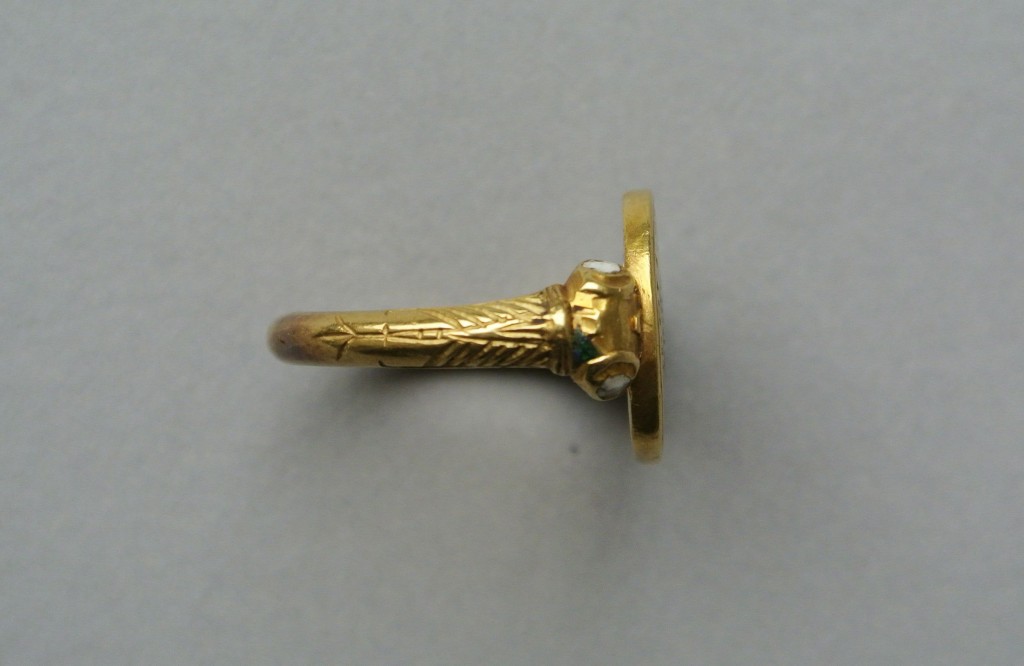

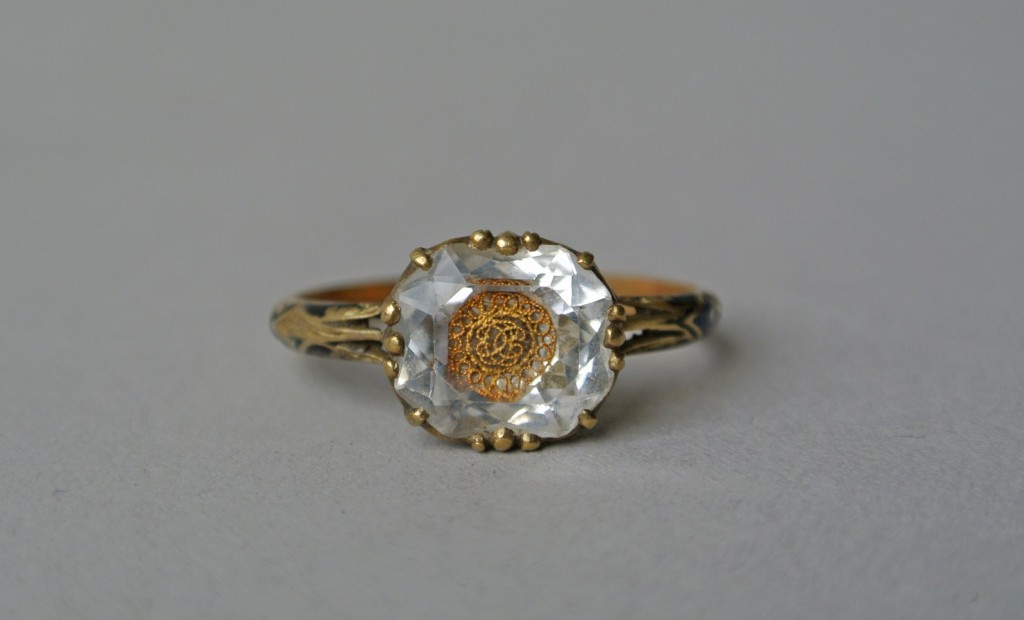

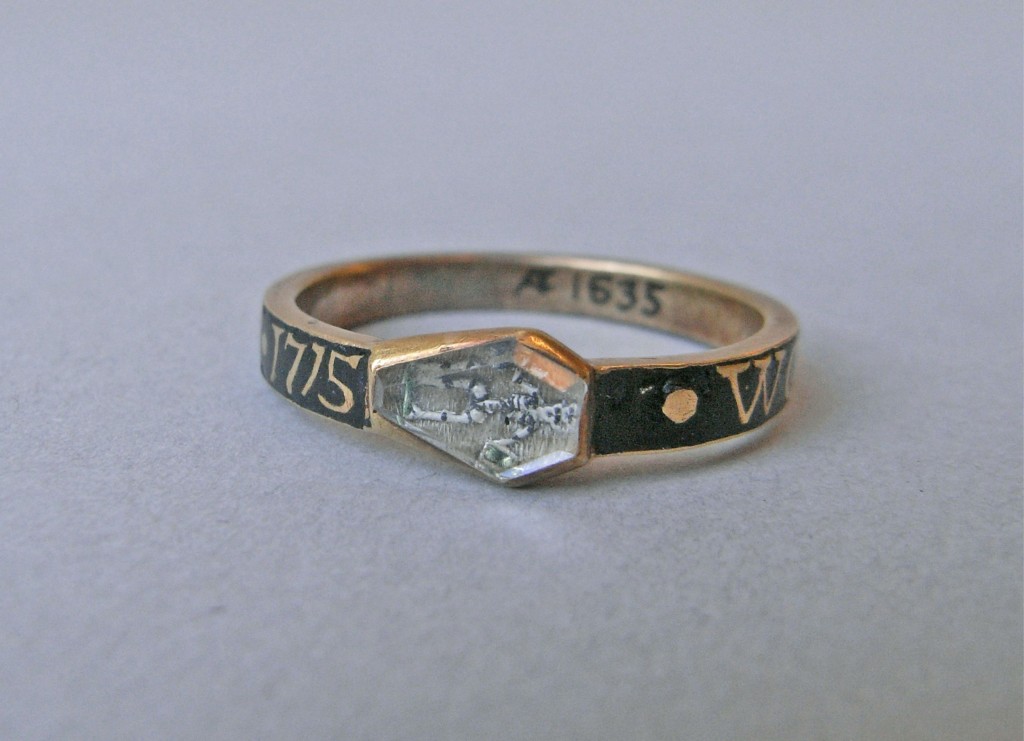

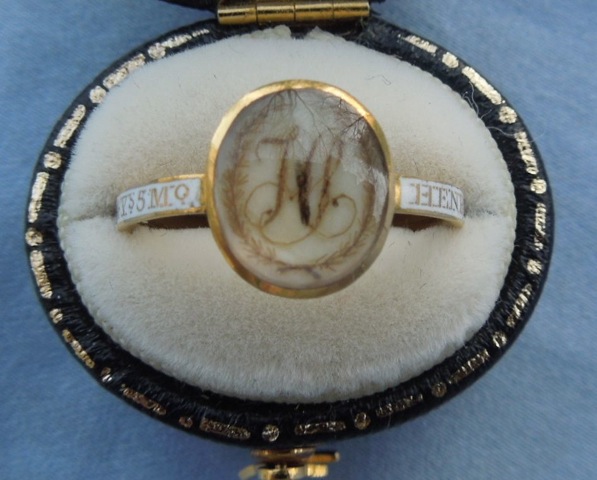
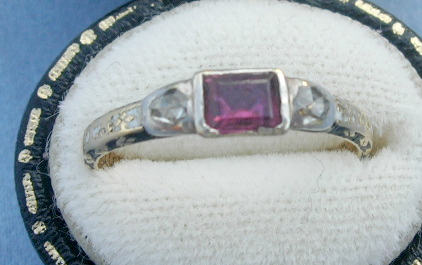
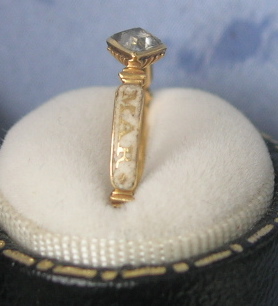




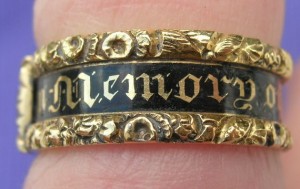





Comments
Post a Comment